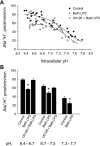Basolateral LPS inhibits NHE3 and HCOFormula absorption through TLR4/MyD88-dependent ERK activation in medullary thick ascending limb
- PMID: 21881005
- PMCID: PMC3233797
- DOI: 10.1152/ajpcell.00237.2011
Basolateral LPS inhibits NHE3 and HCOFormula absorption through TLR4/MyD88-dependent ERK activation in medullary thick ascending limb
Abstract
Sepsis is associated with defects in renal tubule function, but the underlying mechanisms are incompletely understood. Recently, we demonstrated that Gram-negative bacterial lipopolysaccharide (LPS) inhibits HCO(3)(-) absorption in the medullary thick ascending limb (MTAL) through activation of Toll-like receptor 4 (TLR4). Here, we examined the mechanisms responsible for inhibition of HCO(3)(-) absorption by basolateral LPS. Adding LPS to the bath decreased HCO(3)(-) absorption by 30% in rat and mouse MTALs perfused in vitro. The inhibition of HCO(3)(-) absorption was eliminated by the mitogen-activated protein kinase/extracellular signal-regulated kinase (MEK)/ERK inhibitors U0126 and PD98059. LPS induced a rapid (<15 min) and sustained (up to 60 min) increase in ERK phosphorylation in microdissected MTALs that was blocked by PD98059. The effects of basolateral LPS to activate ERK and inhibit HCO(3)(-) absorption were eliminated in MTALs from TLR4(-/-) and myeloid differentiation factor 88 (MyD88)(-/-) mice but were preserved in MTALs from TIR (Toll/interleukin-1 receptor) domain-containing adapter-inducing interferon-β (Trif)(-/-) mice. Basolateral LPS decreased apical Na(+)/H(+) exchanger 3 NHE3 activity through a decrease in maximal velocity (V(max)). The inhibition of NHE3 by LPS was eliminated by MEK/ERK inhibitors. LPS inhibited HCO(3)(-) absorption despite the presence of physiological stimuli that activate ERK in the MTAL. We conclude that basolateral LPS inhibits HCO(3)(-) absorption in the MTAL through activation of a TLR4/MyD88/MEK/ERK pathway coupled to inhibition of NHE3. These studies identify NHE3 as a target of TLR4 signaling in the MTAL and show that bacterial molecules can impair the absorptive functions of renal tubules through inhibition of this exchanger. The ERK pathway links TLR4 to downstream modulation of ion transport proteins and represents a potential target for treatment of sepsis-induced renal tubule dysfunction.
Figures








Comment in
-
Uncovering the pathway of sepsis-induced renal tubular dysfunction. Focus on "Basolateral LPS inhibits NHE3 and HCOFormula absorption through TLR4/MyD88-dependent ERK activation in medullary thick ascending limb".Am J Physiol Cell Physiol. 2011 Dec;301(6):C1290-2. doi: 10.1152/ajpcell.00350.2011. Epub 2011 Sep 21. Am J Physiol Cell Physiol. 2011. PMID: 21940669 No abstract available.
Similar articles
-
High-mobility group box 1 inhibits HCO(3)(-) absorption in medullary thick ascending limb through a basolateral receptor for advanced glycation end products pathway.Am J Physiol Renal Physiol. 2015 Oct 15;309(8):F720-30. doi: 10.1152/ajprenal.00227.2015. Epub 2015 Jul 15. Am J Physiol Renal Physiol. 2015. PMID: 26180239 Free PMC article.
-
Lumen LPS inhibits HCO3(-) absorption in the medullary thick ascending limb through TLR4-PI3K-Akt-mTOR-dependent inhibition of basolateral Na+/H+ exchange.Am J Physiol Renal Physiol. 2013 Aug 15;305(4):F451-62. doi: 10.1152/ajprenal.00102.2013. Epub 2013 May 22. Am J Physiol Renal Physiol. 2013. PMID: 23698118 Free PMC article.
-
Toll-like receptor 2 is required for LPS-induced Toll-like receptor 4 signaling and inhibition of ion transport in renal thick ascending limb.J Biol Chem. 2012 Jun 8;287(24):20208-20. doi: 10.1074/jbc.M111.336255. Epub 2012 Apr 20. J Biol Chem. 2012. PMID: 22523073 Free PMC article.
-
H+ and HCO3- transporters in the medullary thick ascending limb of the kidney: molecular mechanisms, function and regulation.Kidney Int Suppl. 1998 Apr;65:S36-41. Kidney Int Suppl. 1998. PMID: 9551430 Review.
-
IRF3 function and immunological gaps in sepsis.Front Immunol. 2024 Feb 5;15:1336813. doi: 10.3389/fimmu.2024.1336813. eCollection 2024. Front Immunol. 2024. PMID: 38375470 Free PMC article. Review.
Cited by
-
Physiological aspects of Toll-like receptor 4 activation in sepsis-induced acute kidney injury.Acta Physiol (Oxf). 2017 Mar;219(3):573-588. doi: 10.1111/apha.12798. Epub 2016 Oct 8. Acta Physiol (Oxf). 2017. PMID: 27602552 Free PMC article. Review.
-
Epithelial transport during septic acute kidney injury.Nephrol Dial Transplant. 2014 Jul;29(7):1312-9. doi: 10.1093/ndt/gft503. Epub 2013 Dec 29. Nephrol Dial Transplant. 2014. PMID: 24378526 Free PMC article. Review.
-
Monophosphoryl lipid A induces protection against LPS in medullary thick ascending limb through a TLR4-TRIF-PI3K signaling pathway.Am J Physiol Renal Physiol. 2017 Jul 1;313(1):F103-F115. doi: 10.1152/ajprenal.00064.2017. Epub 2017 Mar 29. Am J Physiol Renal Physiol. 2017. PMID: 28356284 Free PMC article.
-
Sisters in arms: myeloid and tubular epithelial cells shape renal innate immunity.Am J Physiol Renal Physiol. 2013 May 15;304(10):F1243-51. doi: 10.1152/ajprenal.00101.2013. Epub 2013 Mar 20. Am J Physiol Renal Physiol. 2013. PMID: 23515715 Free PMC article. Review.
-
High-mobility group box 1 inhibits HCO(3)(-) absorption in medullary thick ascending limb through a basolateral receptor for advanced glycation end products pathway.Am J Physiol Renal Physiol. 2015 Oct 15;309(8):F720-30. doi: 10.1152/ajprenal.00227.2015. Epub 2015 Jul 15. Am J Physiol Renal Physiol. 2015. PMID: 26180239 Free PMC article.
References
-
- Alexander RT, Grinstein S. Tethering, recycling and activation of the epithelial sodium-proton exchanger, NHE-3. J Exp Biol 212: 1630–1637, 2009 - PubMed
-
- Alpern RJ. Renal acidification mechanisms. In: The Kidney, edited by Brenner BM, Rector FC., Jr Philadelphia, PA: Saunders, 2000, Vol. I, p. 455–519
-
- Amemiya M, Loffing J, Lotscher M, Kaissling B, Alpern RJ, Moe OW. Expression of NHE-3 in the apical membrane of rat renal proximal tubule and thick ascending limb. Kidney Int 48: 1206–1215, 1995 - PubMed
-
- Banerjee A, Gerondakis S. Coordinating TLR-activated signaling pathways in cells of the immune system. Immunol Cell Biol 85: 420–424, 2007 - PubMed
Publication types
MeSH terms
Substances
Grants and funding
LinkOut - more resources
Full Text Sources
Medical
Molecular Biology Databases
Miscellaneous

